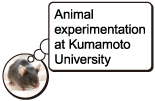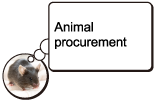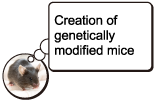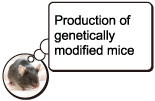Mice breeding method
The following explains the method of breeding used for the largest number of mice bred at the Animal Facility (natural mating method).(Based on the individual mouse or strain, litter-size and weaning time may vary)
Principles
An outline of mouse breeding by the natural mating method is as follows.- Male mice and female mice live together in a cage where they mate, and then after a gestation period of about 20 days, baby mice are born.

- From one doe, 5 to 10 baby mice can be produced (this varies due to strain).
- Baby mice are weaned from four weeks after birth and can be then raised independently.
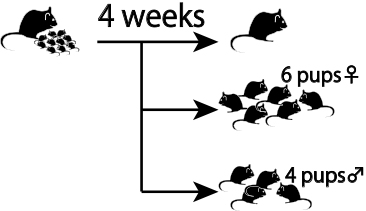
- 8 weeks after birth they are sexually mature and then males and females can be mated to produce further offspring.
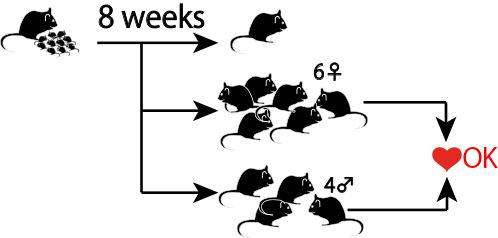
An important point is to understand the following: when the mating took place, was the mating successful, and which mouse gave birth to the baby mice.
Without this knowledge the following adverse effects may occur:
- - mating a female mouse that has already been mated does not increase breeding rate
- - a female mouse that is mated with continuously will be tired and thus the breeding rate will not increase
- - More than one male mouse can lead to fighting over a female and result in injuries
Mating method
Cage separation
- Female and male mice are obtained and put into separate cages where they are raised.
- A few days before mating is to begin, male mice will be kept individually (1 mouse per cage) and female mice will be kept in a herd (5 mice per cage).

Creating the Next Generation through Breeding
- Keeping the following points in mind, the male and female mice are then put together and mated.
- Sexual maturity: both male and female mice are sexually mature at 8 weeks and can mate and give birth.
- Sexual cycle: the vulva of the female mouse is observed and when it becomes swollen and red (this shows that the sexual cycle is at the proestrus point), she is chosen for mating and thus breeding rate increases.
(For information about the swelling of the vulva, please refer to the photo [proestrus] on this page) - Indigenous effect: When a female is placed in the male mouse cage, breeding rate increases.
- Numbers of mice: For every male mouse, one to two female mice.
- Time: Male and female mice are put together in the evening.
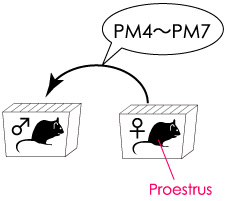
- The next morning, the female vulva are observed and if the vaginal plug is observed, mating has taken place.
Since the vaginal plug will fall off by noon, observation must be done in the morning.
A log is then kept recording information about the male and female mice who are to become parents and the date that the vaginal plug has been confirmed.
- Female mice whose vaginal plug has been confirmed are kept together in one cage
- A few days before the delivery date (20 days after confirmation of vaginal plug), each mouse is given their own cage and a message is put on the cage which reads "Delivery date is near so please don't replace this cage" thus removing any extra excitement from replacement of cages, etc.
- For one week after delivery, cages aren't replaced while the mother nurses her young.
- Four weeks after delivery, the baby mice are weaned.
The male and female mice are then divided into separate cages
To ensure sufficient space per animal, the mice are divided as to not to exceed 5 mice per cage.
- After 8 weeks from birth, the mice can be mated for offspring.
Efficient breeding technology
n the Animal Facility, we have established efficient mouse breeding technology using in vitro fertilization instead of natural mating. Using this technology, a large number of pups can be bred, some 100 eggs per female can be fertilized.Interested parties should contact the Mouse Bank system staff.
Caution
Handling of genetically modified organisms is strictly defined by law. For this reason, if something were to happen, such as if genetically modified animals escape from the facility, facilities and researchers will be punishable by law.Even in the breeding room, please let the facility staff when a mouse has escaped from a cage. We have specialized tools for capturing the mice and we will cooperate to ensure return of animals to their cages.
cardadmi
->Contact List (Internal University use only)
NEWS
- New web site is opened.
2016.03.31
SUPPORT
ACTIVITIES
STAFF
Kumamoto University
Institute of Resource Development and Analysis
Center for Animal Resources and Development
〒860-0811
2-2-1 Honjo, Chuo-ku, Kumamoto-shi
TEL :096-373-6550
FAX :096-373-6552
Email :mimura(a)kumamoto-u.ac.jp
Liaison:Imura
Contact List (Internal University use only)
Institute of Resource Development and Analysis
Center for Animal Resources and Development
〒860-0811
2-2-1 Honjo, Chuo-ku, Kumamoto-shi
TEL :096-373-6550
FAX :096-373-6552
Email :mimura(a)kumamoto-u.ac.jp
Liaison:Imura
Contact List (Internal University use only)

